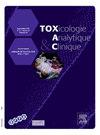Methylone intoxication in a strangulation death: Suicide, homicide or overdose?
IF 1.7
Q4 TOXICOLOGY
引用次数: 0
Abstract
Aim
Methylone (MDMC, BK-MDMA) is a synthetic cathinone with entactogenic and euphoric properties which, according to the literature and the DRAMES survey in France, is rarely found in toxic deaths today. We present here a case of potentially lethal intoxication, with measurement of blood, urine, tissues and hair methylone concentrations. A 45-year-old woman who had been missing for 5 days after a swinger's party and a violent argument with her partner was found dead in a semi-seated position, hanging by the handle of her backpack from the branch of a tree. According to the investigation, alcohol and MDMA were consumed during the evening. The Prosecutor's Office request an autopsy and toxicological analyses as part of the investigation into the cause of death.
Method
Analyses are carried out using the laboratory's usual techniques (GC/FID, GC-MS, LC-MS/MS), including the detection and determination of blood alcohol, narcotics, drugs including psychotropic drugs and synthetic products. A specific LC-MS/MS method was used to perform determination for methylone with methylone-D3 as internal standard, on all available specimen.
Results
Macroscopic autopsy data favoured violent death following strangulation by cervical hanging, with a possible toxic contribution, and did not rule out the intervention of a third party. Toxicological analyses identified ethanol (2.2 g/L), THC (0.5 μg/L) and THC COOH (1 μg/L), benzoylecgonine (27 μg/L), and amphetamine in blood. Methylone was identified in all samples at the following concentrations: 1450 μg/L (heart blood), 1341 μg/L (peripheral blood), 7494 μg/L (urine), 4937 μg/L (bile), 2.4 mg/Kg (brain), 2.5 mg/Kg (lung), 1.5 mg/Kg (kidney), 3.5 mg/Kg (liver) and 1.3 mg/Kg (heart). To check whether the subject was a chronic consumer, a hair analysis was also carried out. 3 segments of 4 cm were taken. Methylone was quantified at concentrations of 10,000; 3,350 and 2,360 pg/mg respectively. THC, CBD, amphetamine, MDMA, cocaine and metabolites were also identified in the 3 segments.
Cathinones can be sold instead of MDMA, because they have similar properties, are euphoric and increase sociability. Only a few data are published in the literature on methylone. Concentrations of 60 to 3300 μg/L (mean: 835 μg/L) in heart blood, 500 to 3300 μg/L (mean: 1174 μg/L) in peripheral blood, 420 to 1800 μg/L in bile, 0.16 to 2.3 mg/Kg in kidney and 0.14 to 1.8 mg/Kg in liver, are described in several fatality cases in 2012 (Pearson, J Anal Toxicol, 2012, 36, 444–451; Cawrse, J Anal Toxicol, 2012, 36, 434–439) and from 6 to 98 pg/mg in hair tested positive (Salomone, J Anal Toxicol, 2017, 41, 376–381). The concentrations measured in our case are in favour of very recent consumption, potentially lethal and compatible with an overdose without it being possible to establish the contribution of intoxication to death. Hair analysis provides information on the subject's drug use profile over several months and supports significant methylone use in the period preceding death.
Conclusion
This case illustrates the still existing use of methylone which was rather “fashionable” ten years ago among synthetic cathinones. It underlines the importance of including these molecules in the reference toxicological expertise in accordance with the recently published SFTA recommendations for the investigation of NPS (https://www.sfta.org/articles/view/recommandations-de-la-sfta-pour-la-realisation-des-analyses-toxicologiques-impliquant-des-nps-version-2024) as part of the search for causes of death. Quantification in various biological specimen enrich existing data, and capillary analysis can highlight regular consumption of this cathinone.
勒死人中的甲酮中毒:自杀、他杀还是用药过量?
目的甲酮(MDMC,BK-MDMA)是一种合成卡西酮,具有诱导和兴奋特性,根据文献和法国 DRAMES 调查,目前很少在中毒死亡病例中发现这种物质。我们在此介绍一例可能致命的中毒病例,并对血液、尿液、组织和毛发中的甲酮浓度进行了测量。一名 45 岁的妇女在一次游荡派对上与伴侣发生激烈争吵后失踪了 5 天,被发现时处于半坐姿,背包的手柄挂在树枝上,已经死亡。根据调查,她当晚饮用了酒精和摇头丸。方法使用实验室的常规技术(GC/FID、GC-MS、LC-MS/MS)进行分析,包括检测和测定血液中的酒精、麻醉剂、毒品(包括精神药物和合成产品)。在所有可用的样本中,使用了一种特殊的 LC-MS/MS 方法,以甲基酮-D3 为内标,对甲基酮进行了测定。毒理学分析确定血液中含有乙醇(2.2 克/升)、四氢大麻酚(0.5 微克/升)和四氢大麻酚 COOH(1 微克/升)、苯甲酰可待因(27 微克/升)和苯丙胺。在所有样本中鉴定出的甲酮浓度如下1450微克/升(心血)、1341微克/升(外周血)、7494微克/升(尿液)、4937微克/升(胆汁)、2.4毫克/千克(脑)、2.5毫克/千克(肺)、1.5毫克/千克(肾)、3.5毫克/千克(肝)和1.3毫克/千克(心脏)。为检查受试者是否为长期服用者,还对其头发进行了分析。取 4 厘米长的头发 3 根。甲酮的定量浓度分别为 10,000 皮克/毫克、3,350 皮克/毫克和 2,360 皮克/毫克。在这 3 段毛发中还检测出了四氢大麻酚、大麻二酚、苯丙胺、亚甲二氧基甲基苯丙胺、可卡因和代谢物。有关甲酮的文献只发表了少量数据。心血中的浓度为 60 至 3300 微克/升(平均值:835 微克/升),外周血中的浓度为 500 至 3300 微克/升(平均值:1174 微克/升),胆汁中的浓度为 420 至 1800 微克/升,肾脏中的浓度为 0.16 至 2.3 毫克/千克,肝脏中的浓度为 0.14 至 1.8 毫克/千克。肝脏中的浓度为 0.16 至 2.3 毫克/千克,肝脏中的浓度为 0.14 至 1 毫克/千克,这在 2012 年的几例死亡病例中有所描述(Pearson,J Anal Toxicol,2012,36,444-451;Cawrse,J Anal Toxicol,2012,36,434-439),头发中的检测呈阳性的浓度为 6 至 98 皮克/毫克(Salomone,J Anal Toxicol,2017,41,376-381)。在我们的案例中测得的浓度表明最近服用过这种药物,有可能致命,并且与用药过量相符,但无法确定中毒导致死亡的原因。毛发分析提供了受试者几个月来使用毒品的情况,并证明在死亡前的一段时间内使用了大量甲酮。它强调了根据最近发布的 SFTA 关于调查 NPS 的建议(https://www.sfta.org/articles/view/recommandations-de-la-sfta-pour-la-realisation-des-analyses-toxicologiques-impliquant-des-nps-version-2024)将这些分子纳入参考毒理学专业知识的重要性,这也是寻找死亡原因的一部分。各种生物标本中的定量分析丰富了现有数据,毛细管分析可突出显示这种卡西酮的定期消费情况。
本文章由计算机程序翻译,如有差异,请以英文原文为准。
求助全文
约1分钟内获得全文
求助全文

 求助内容:
求助内容: 应助结果提醒方式:
应助结果提醒方式:


